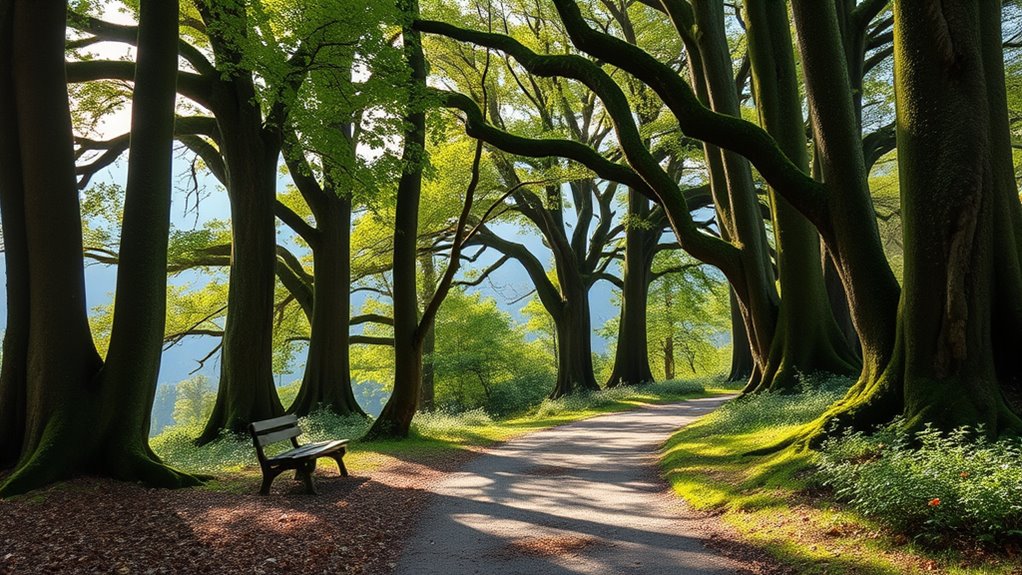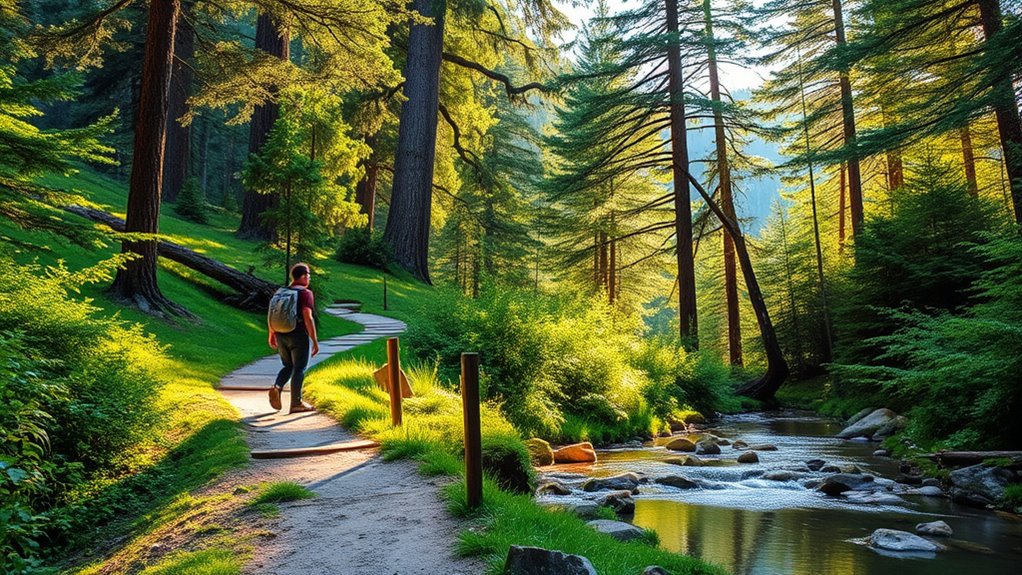The art of slow travel offers a powerful way to restore your mental well-being by encouraging mindfulness and deep cultural immersion. When you take your time, you can connect authentically with your surroundings, noticing small details and engaging with local communities. This reduces stress, enhances empathy, and cultivates present-moment awareness. Pacing yourself allows for reflection and emotional clarity, making your journey truly restorative. If you continue exploring, you’ll uncover how to turn travel into a mindful mental retreat.
Key Takeaways
- Embrace mindfulness by engaging fully with your surroundings, enhancing presence and reducing mental clutter during travel.
- Spend ample time in fewer destinations to foster reflection, deeper understanding, and mental rejuvenation.
- Connect authentically with local communities through conversations and cultural activities, promoting empathy and emotional well-being.
- Incorporate intentional self-care practices like spiritual retreats or wellness activities to support holistic mental health.
- Focus on sensory experiences—sounds, smells, sights—to anchor awareness in the present and cultivate relaxation.

In a fast-paced world that often leaves you feeling overwhelmed, embracing the art of slow travel offers a powerful way to rejuvenate your mind. Instead of rushing from one tourist spot to another, you take the time to truly connect with your surroundings. This approach encourages mindfulness practices, which help you stay present and aware of every moment. By slowing down, you give yourself permission to breathe deeply, notice the small details, and appreciate the nuances of each place you visit. It’s not about ticking off a checklist but immersing yourself fully in the experience.
Embrace slow travel to connect deeply, stay present, and truly appreciate each moment of your journey.
When you opt for slow travel, local cultural immersion becomes a natural part of your journey. You might find yourself sitting in a neighborhood café, chatting with locals, or participating in traditional crafts. These authentic interactions allow you to see the world from a different perspective, fostering empathy and understanding. Instead of observing from a distance, you become part of the community, which enriches your mental state and reduces stress. Engaging with local customs and traditions helps you break free from the superficial tourist experience, grounding you in the essence of a place and its people.
Practicing mindfulness during your travels can be as simple as paying close attention to the sounds, smells, and sights around you. When you walk through a market, notice the vibrant colors, listen to the chatter of vendors, and feel the textures of the fruits and fabrics. These small acts of awareness anchor you in the present, diminishing worries about the future or regrets about the past. As you cultivate this mindfulness, you’ll find it easier to relax and let go of mental clutter. Over time, this mindful approach becomes a habit, not just during your travels but in everyday life.
Slow travel also encourages you to spend more time in fewer places, giving you the space to reflect and process your experiences. You might linger longer in a charming village or a quiet park, allowing your mind to settle and your thoughts to deepen. This deliberate pacing offers a break from the constant rush, reducing anxiety and promoting mental clarity. By choosing quality over quantity, you create meaningful moments that leave a lasting positive impact on your mental health. Ultimately, slow travel isn’t just about destination; it’s about transformation—giving you the chance to reconnect with yourself and the world around you in a more mindful, enriching way.
Additionally, engaging in spiritual retreats or wellness activities during your travels can enhance mental restoration by providing dedicated spaces for reflection and healing.
Frequently Asked Questions
How Does Slow Travel Specifically Improve Mental Health?
Slow travel improves your mental health by allowing you to practice mindfulness practices, helping you stay present and reduce stress. It encourages cultural immersion, which broadens your perspective and fosters a sense of connection. By taking your time, you avoid the rush and overwhelm common in fast-paced travel, helping you relax and recharge mentally. This intentional approach supports emotional well-being and cultivates a deeper appreciation for your experiences.
What Are the Best Destinations for Slow Travel?
When choosing destinations for slow travel, you want places that encourage cultural immersion and local cuisine. Consider small towns or rural areas where you can walk leisurely, interact with locals, and savor authentic dishes. Countries like Italy, Japan, or Greece offer rich traditions and scenic landscapes perfect for taking your time. These destinations let you connect deeply with the culture, helping you unwind and rejuvenate mentally.
How Can Beginners Start Practicing Slow Travel?
Imagine stepping into a time machine, but it’s just your mindset shifting. To start slow travel, embrace local cuisine and truly engage in cultural immersion. Choose small, walkable destinations and spend days exploring at a relaxed pace. Talk to locals, savor every bite, and take your time. By doing so, you’ll cultivate a deeper connection with your surroundings, making your travel more enriching and restorative.
What Are Common Challenges Faced During Slow Travel?
During slow travel, you might face challenges like balancing cultural immersion with comfort, or managing local interactions that can feel overwhelming. You could struggle with patience when things don’t go as planned or feel frustrated by language barriers. However, embracing these moments helps you connect more deeply with the environment, enriching your experience. Remember, taking small steps and staying open makes overcoming these challenges rewarding and enhances your journey.
How Does Slow Travel Compare to Traditional Fast-Paced Tourism?
You’ll find slow travel offers a richer experience compared to traditional fast-paced tourism. Instead of rushing through sights, you immerse yourself in local customs and culture, fostering meaningful connections. Travel logistics become smoother as you plan longer stays, reducing stress. This approach allows you to truly relax, absorb your surroundings, and enjoy a more authentic journey, making your trip more memorable and fulfilling.
Conclusion
So, slow down, savor, and strengthen your spirit through the simple, soulful act of slow travel. Let each lingering moment lift your mood, soothe your stress, and spark your senses. Embrace the art of taking your time, trusting that true transformation unfolds in the tranquil, timeless tick of time. Remember, in the gentle glide of gradual journeys, you’ll find peace, purpose, and a profound path to mental restoration. Travel slowly, and truly thrive.









